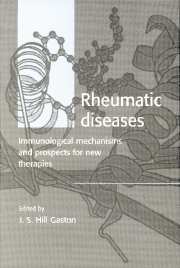Book contents
- Frontmatter
- Contents
- List of contributors
- 1 Implications of advances in immunology for understanding the pathogenesis and treatment of rheumatic disease
- 2 The role of T cells in autoimmune disease
- 3 The role of MHC antigens in autoimmunity
- 4 B cells: formation and structure of autoantibodies
- 5 The role of CD40 in immune responses
- 6 Manipulation of the T cell immune system via CD28 and CTLA-4
- 7 Lymphocyte antigen receptor signal transduction
- 8 The role of adhesion mechanisms in inflammation
- 9 The regulation of apoptosis in the rheumatic disorders
- 10 The role of monokines in arthritis
- 11 T lymphocyte subsets in relation to autoimmune disease
- 12 Complement receptors
- Index
6 - Manipulation of the T cell immune system via CD28 and CTLA-4
Published online by Cambridge University Press: 06 September 2009
- Frontmatter
- Contents
- List of contributors
- 1 Implications of advances in immunology for understanding the pathogenesis and treatment of rheumatic disease
- 2 The role of T cells in autoimmune disease
- 3 The role of MHC antigens in autoimmunity
- 4 B cells: formation and structure of autoantibodies
- 5 The role of CD40 in immune responses
- 6 Manipulation of the T cell immune system via CD28 and CTLA-4
- 7 Lymphocyte antigen receptor signal transduction
- 8 The role of adhesion mechanisms in inflammation
- 9 The regulation of apoptosis in the rheumatic disorders
- 10 The role of monokines in arthritis
- 11 T lymphocyte subsets in relation to autoimmune disease
- 12 Complement receptors
- Index
Summary
Introduction
In order to provide protection from a vast array of infectious agents, the immune system has evolved a series of defences based on specialized immune cells. One component of this system, the T lymphocyte, is critical in organizing and effecting cellular responses by providing helper functions for B cells, as well as by generating direct cytotoxic actions. The major challenge faced in controlling T cell responses is how to generate a sufficiently large immune repertoire capable of recognizing any possible foreign antigen while at the same time maintaining T cells in an unresponsive state towards an equally large array of self-antigens. Clearly any breakdown in the barriers that prevent recognition and activation of T cells by self-antigens allows the possibility of developing autoimmune conditions, which include RA and SLE. In order to gain an understanding of potential disease mechanisms and to provide initiatives for novel therapeutic strategies, it is necessary to understand these mechanisms of T cell tolerance.
Since the late 1970s, substantial progress has been made in our understanding of the molecular basis of antigen recognition by T cells. Based on the observations of Zinkernagel and Doherty, who demonstrated that T cell recognition of foreign antigens requires appropriate (self) MHC antigens, it is now well established that the function of MHC class I and class II antigens is to bind and display both self and non-self peptide fragments on the cell surface (Zinkernagel & Doherty, 1974; 1975; Brown et al., 1993). In the case of MHC class II molecules (HLA-DR, HLA-DQ and HLA-DP), expression is generally restricted to professional antigen-presenting cells, such as dendritic cells, monocytes, macrophages and activated B cells.
- Type
- Chapter
- Information
- Rheumatic DiseasesImmunological Mechanisms and Prospects for New Therapies, pp. 93 - 118Publisher: Cambridge University PressPrint publication year: 1999



